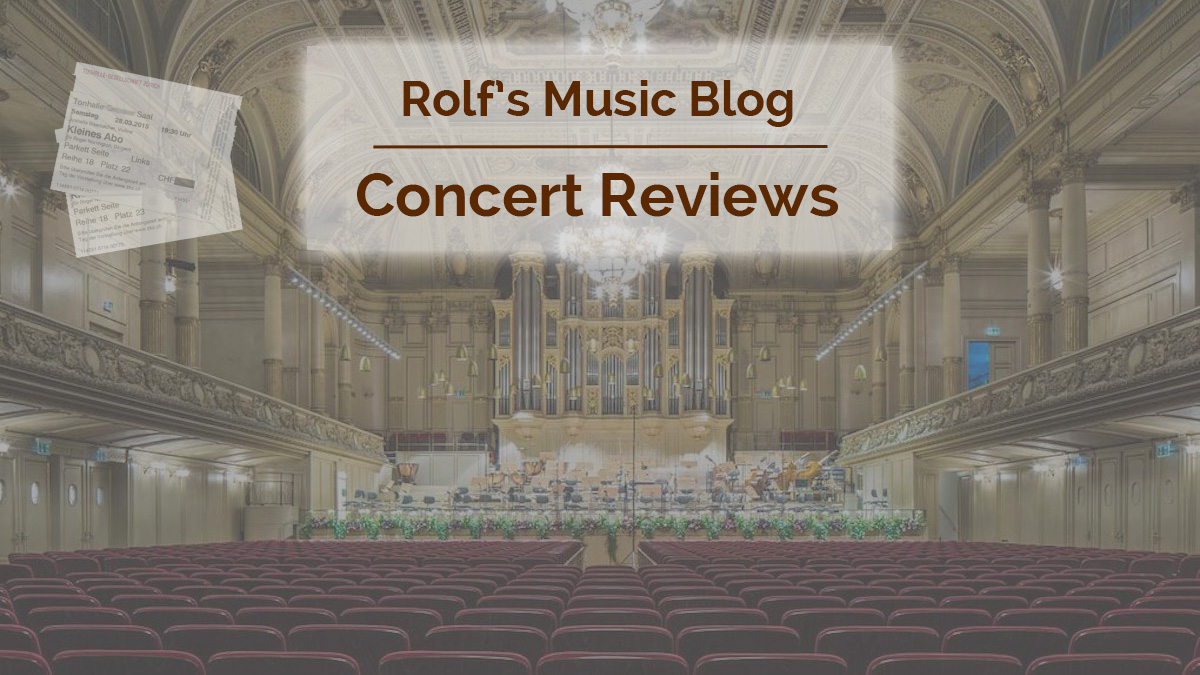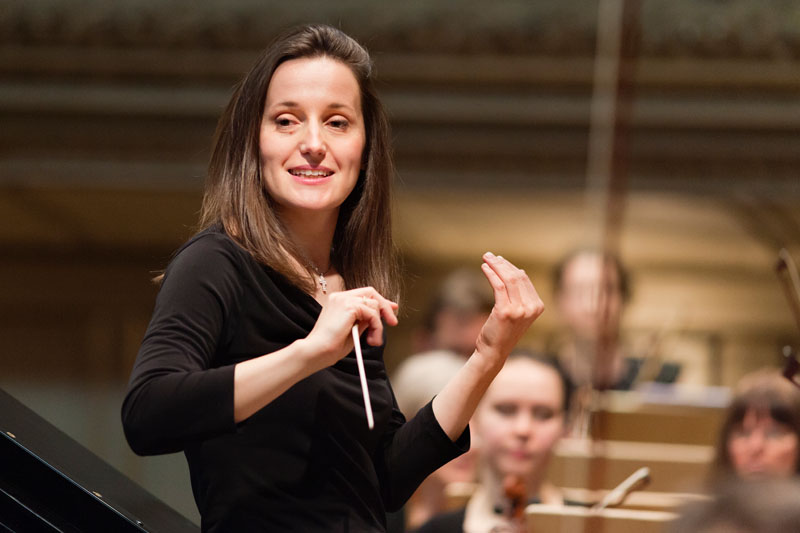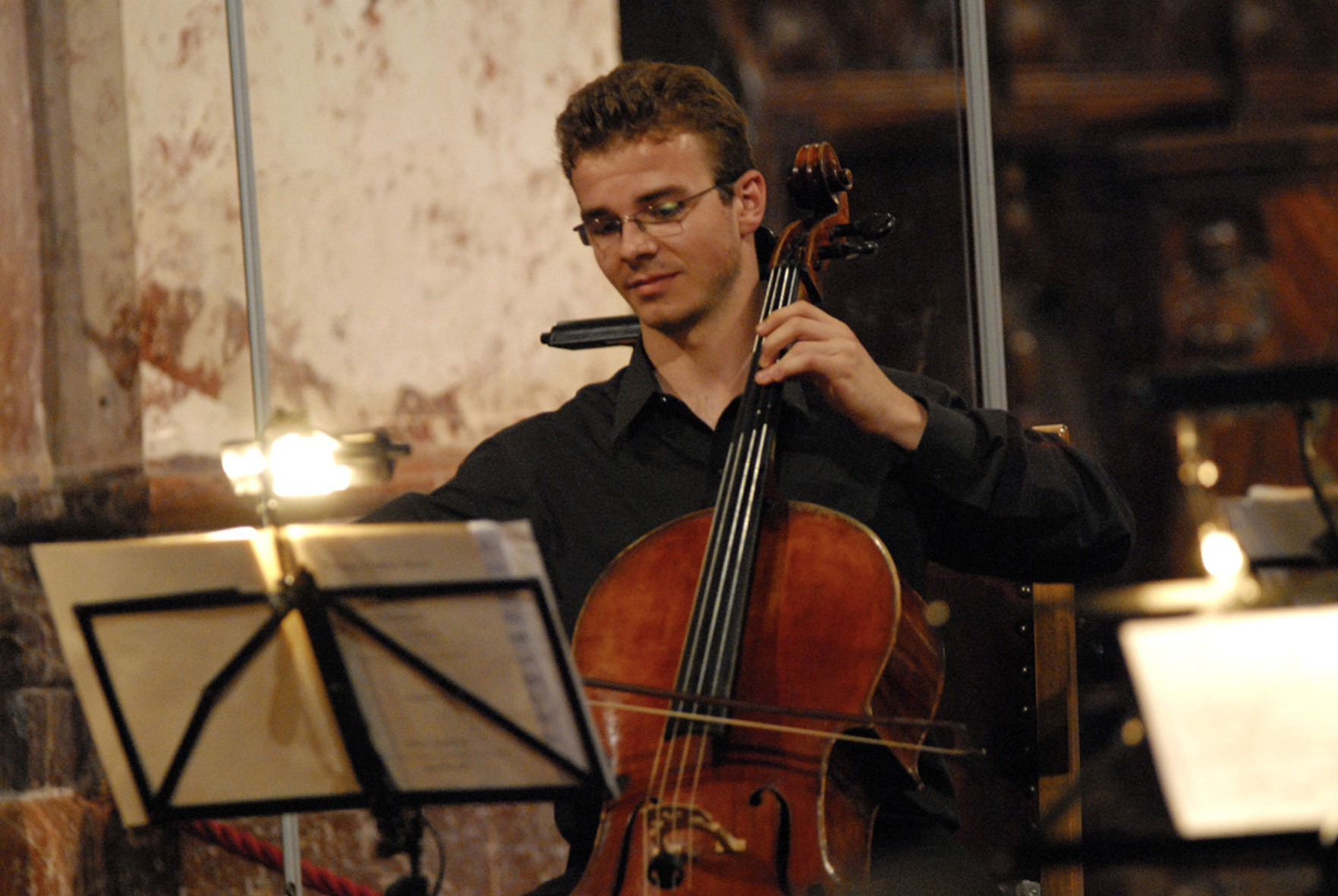Benjamin Nyffenegger, Olivera Sekulić-Barac / OGZ
Works by Pyotr Ilyich Tchaikovsky (1840 – 1893)
Tonhalle Zurich, 2017-06-25
2017-07-02 — Original posting
Ambitioniert oder ambitiös? Die Orchestergesellschaft Zürich mit Benjamin Nyffenegger — Zusammenfassung
Die Orchestergesellschaft Zürich ist ein Klangkörper aus “ambitionierten Amateur-MusikerInnen”. Das Orchester präsentierte unter der Leitung von Olivera Sekulić-Barac ein Konzert ausschließlich mit Werken von Tschaikowsky. Die Polonaise aus “Eugen Onegin” ist populär, schwungvoll, rhythmisch mitreißend, die Aufführung insgesamt von beachtlicher Qualität, speziell mit guten Bläsersoli. Ein ausgezeichneter Beginn!
In der Folge spielte der Cellist Benjamin Nyffenegger Tschaikowskys Rokoko-Variationen. Tschaikowskys umsichtiger Orchesterdisposition ist es zu verdanken, dass das Solo mit seinem warmen, singenden Klang von der ersten Note weg Präsenz markiert. Es dominiert gar die Szene, degradiert das Orchester zur reinen Begleitung. Nyffenegger hat mit dem anspruchsvollen Cellopart technisch keinerlei Probleme, er artikuliert leicht, aber dennoch mit intensivem Ton, behält Kontakt mit der Dirigentin. Gelegentlich zeigt er eine gewisse Tendenz zu tiefer Intonation, und die virtuose Coda gerät etwas summarisch.
Nach der Pause folgte die Fünfte Sinfonie in e-Moll. Von Beginn weg traf das Orchester die Grundstimmung, den Charakter des anspruchsvollen Werks gut: Olivera Sekulić ist mit dieser Musik vertraut, führte den Klangkörper sicher. Speziell liegen ihr die tänzerischen, schwingenden Momente. Sie achtete auf die Gesangslinien, auf das Legato in den lyrischen Passagen. Die Koordination bei den Pizzicati war ausgezeichnet, die Streicher generell gut, homogen. Sehr zu liegen schien der Dirigentin der dritte Satz, ein Walzer. Das Finale hat seine Tücken. So waren zum Beispiel die Sechzehntelpaare des Beginns in den Streichern (und später im Blech) als solche kaum wahrnehmbar. Mit zusätzlicher agogischer Freiheit hätte das schöne Thema ruhig mehr ausgekostet werden können. Das Allegro vivace geriet dann eindeutig zu schnell und damit oberflächlich. Und in den Bläsern drohte das Chaos. Olivera Sekulić hat ihr Orchester keineswegs geschont!
Table of Contents
Introduction
The Orchestergesellschaft Zürich (Zurich Orchestral Society, OGZ) describes itself as “ambitioned amateurs’ orchestra”. It’s a club that goes back to 1947—it is the result of a transformation of a predecessor orchestra, the “Dilettantenorchester Küsnacht”. Every year, they perform at least one concert at Zurich Tonhalle, complemented by 1 – 2 additional concerts in other venues, mostly in the region around Zurich. This concert celebrated the orchestra’s 70th anniversary—and it featured a demanding, pure Tchaikovsky program.
Since 2014, Olivera Sekulić-Barac (*1979) is conducting the orchestra. Already at age 16, she started conducting her own choir, then studied conducting first in Belgrade, from 2002 on at the ZHdK in Zurich. After concluding her studies in 2009, she started a conducting career with both orchestras and choirs, not just in Switzerland, but also in other European countries, such as Germany, the Czech Republic, Serbia, and various others.
Reviewing Concerts with Non-Professional Orchestras
This is the second time that I’m reviewing a concert with a non-professional orchestra (the first one was with a youth orchestra in London). That’s a task that I consider tricky, to say the least. Here’s why:
By performing in the Zurich Tonhalle, the ensemble automatically exposes itself to a comparison with the big, professional orchestras. On the other hand, it is obvious that it is not and will never be able to come close to performances with such internationally active competition. Even though one should note that the OGZ consists of amateur musicians, not lay people: one should assume that all orchestra members have a fair amount of (if not even a full) musical education. They just didn’t make that their profession.
The dilemma for the reviewer is whether one should apply a “professional scale”, or whether one should rather apply a more modest scale that may look more appropriate for an amateur orchestra. To me, the latter option is questionable, both because I’m not regularly attending, let alone reviewing such concerts / orchestras (and hence I don’t have a valid “reference standard”), and also because the spread in non-professional orchestras is huge, ranging from fairly poor (some school orchestras) up to near-professional performances. So, I decided not to apply a “star rating” here, while still applying “professional standards” for my comments (which certainly are also appropriate for the soloist!). With this, I’m trying to position the orchestra on the “grand scale” from a listener’s perspective.
Polonaise from the Opera “Eugene Onegin”, op.24
Tchaikovsky’s opera “Eugene Onegin” (Евгений Онегин), op.24, is based on a novel by Alexander Sergeyevich Pushkin (1799 – 1837). “Eugene Onegin” premiered in Moscow, in 1879. The Polonaise is the opening piece (a dance) for Act III of the opera.
The Performance
The saying goes that “what people in the audience remember about a concert are the first and the last pieces played”. Tchaikovsky’s Polonaise is a very effective opening piece for a concert—and for sure, the orchestra has spent plenty of time rehearsing it! It may have been a bit (too?) solid, not always quite perfect and clear in the coordination across the orchestra, and the dynamics were somewhat restricted: a true p was rare, typically rather mf. On the other hand, the music per se is popular, full of momentum, rhythmically enthralling. Overall, the performance was of respectable quality, and I enjoyed the excellent wind soloists. Certainly a good start into the concert!
Variations on a Rococo Theme in A major, for Cello and Orchestra, op.33
The Making of the Variations
Tchaikovsky never wrote a concerto for cello and orchestra. But 1876/1877 he did compose his famous Variations on a Rococo Theme in A major, for Cello and Orchestra, Op.33. For this composition, he cooperated with the cellist (and fellow professor at the Moscow Conservatory) Wilhelm Fitzenhagen (1848 – 1890), to whom he dedicated the composition, and who also premiered this in 1877, with Nikolai Rubinstein (1835 – 1881) conducting. In its original version, the composition features eight variations:
- Introduction (Moderato assai quasi Andante) — Theme: Moderato semplice
- Var.1: Tempo della Thema
- Var.2: Tempo della Thema
- Var.3: Andante
- Var.4: Allegro vivo
- Var.5: Andante grazioso
- Var.6: Andante
- Var.7: Andante sostenuto
- Var.8 e Coda: Allegro moderato con anima
Fitzenhagen’s Modifications
Sadly, after the premiere, Fitzenhagen did not leave Tchaikovsky’s composition as is. He did some serious re-shuffling, even omitting variation 8 altogether:
- Introduction — Theme: unchanged
- Var.1: same
- Var.2: same, but using the ending from Variation 5
- Var.6
- Var.7
- Var.4
- Var.5: same, but using the ending from Variation 2
- Var.3
- Var.8 omitted — Coda: unchanged
Unfortunately, Fitzenhagen’s version persisted for decades, apparently up till 1941. Still today, the Fitzenhagen version prevails, and very few cellists so far have ever recorded the original version, or played it in concert, Steven Isserlis (*1958) being one of them. It is true that Fitzenhagen had lots of success with performing his version of the variations in concert, and he even bragged about this to the composer, possibly without revealing how much he changed in Tchaikovsky’s original. However, as discussed in the associated Wikipedia article, some 11 years later, Tchaikovsky apparently was very upset about all the changes.
The version performed in this concert was—almost inevitably—Fitzenhagen’s. The latter’s role was mentioned in the program notes to the concert. Understandably, the notes avoided criticizing Fitzenhagen’s modifications, let alone mentioning the composer’s reaction when he learned about the full scope of the changes. However, it would be cheap to criticize the cellist or anyone else about the selection of Fitzenhagen’s version: that version indeed (& sadly) still is the one commonly performed. More importantly, getting the orchestral parts for the original version may be difficult: apparently, the State Publishing House did not issue the orchestral parts with the original version of the Variations in the Russian edition of Tchaikovsky’s complete works.
The Performance
The soloist in the Rococo Variations was Benjamin Nyffenegger (*1984), deputy solo cellist in the Tonhalle Orchestra Zurich, also internationally performing soloist, and member of various chamber music formations.
Thanks to Tchaikovsky’s judicious orchestral disposition, the solo cello marked and maintained its presence from the very first note up to the last variation. This allowed the audience to enjoy the warm, singing tone of this instrument. The cello even dominated the scene, mostly degrading the orchestra to pure accompaniment.
The cellist didn’t seem to have any technical issues with the challenging, virtuosic solo part. He articulated lightly, yet maintained an intense tone, and he kept visual contact with the conductor. The orchestra managed following the cellist’s agogics, his rubato fairly well. Maybe with the exception of some strong accelerandi in the solo part: these proved to be challenging for the accompaniment. In the solo, I noted a certain tendency towards (a tad) low intonation. Also, the soloist’s very virtuosic coda turned out somewhat superficial.
Symphony No.5 in E minor, op.64
Tchaikovsky’s Symphonies No.4, 5, and 6 are very well-known. So, I’ll just mention that Symphony No.5 in E minor, op.64, premiered in 1888, in the year of its composition. This was at the Mariinsky Theater in Saint Petersburg, with the composer conducting. The symphony features four movements:
- Andante — Allegro con anima — Molto più tranquillo
- Andante cantabile, con alcuna licenza — Non allegro — Andante maestoso con piano
- Valse: Allegro moderato — Trio
- Finale: Andante maestoso —Allegro Vivace — Molto vivace — Moderato assai e molto maestoso — Presto
The Performance
Right from the beginning, I felt that the orchestra found and matched the basic character of this technically fairly demanding symphony really well. Olivera Sekulić-Barac is obviously familiar with this music, with the score. She firmly and reliably guided the orchestra, paying special attention to cantilenas, and to legato playing in lyrical passages. She appeared to have a special flair for dancing, swaying moments.
The coordination of Tchaikovsky’s pizzicati was excellent; in general, I liked the homogeneous sound of the string section. Though naturally, it can’t reach the silky quality of top professional ensembles. It’s one big advantage of such (amateur) formations is that a concert program can (and is) rehearsed in many sessions, over several months. This allows the material to settle. Hence, the risks with a concert performance can be minimized. Yes, there are limitations, e.g., in the area of agogics. The orchestra can hardly realize details such as little ritenuti prior to accents or peak notes, let alone spontaneous tempo variations / rubato.
I. Andante — Allegro con anima — Molto più tranquillo
One area in which I noted some limitations is in dynamics. Extreme pp can be very delicate as it can easily sound brittle, may expose weaknesses. So, I often observed that pp turned into mp, if not mf.
But the symphony is even more demanding for the wind instruments. These are often extremely exposed: wind instrument players in orchestras—at least at the first desks—are essentially soloists! The OGZ has some very good musicians in that section, such as the first horn player (see the second movement below). Also the woodwind instruments performed really well, such as the flute, oboe, clarinet, and bassoon. On the other hand, I noted that with other wind instrument players, the intonation occasionally was marginal. I noted this particularly in ensemble playing, such as at the very beginning. Also, the wind section at times tended to be loud in accompaniment roles. Repeated quavers and semiquavers, particularly with the brass instruments, in the outer movements were often blurred, poorly articulated, superficial.
In general, complex textures could often have been clearer. Compared to “the professionals”, the outcome occasionally lacked refinement, subtlety. But in the ff passages, the around 70 members in the orchestra was able to create an amazing volume, with good overall sound quality.
II. Andante cantabile, con alcuna licenza — Non allegro — Andante maestoso con piano
Here, the first hornist deserves a special mention. He articulated clearly, and with excellent phrasing and purity in intonation, particularly in the solo in this movement.
Actually, very often, it was anything but trivial to name key differences between the performance in this concert and a “truly professional” performance. One thing I suspected is that lacking agogic detail, lack of refinement, of “life” in articulation caused the inner movements to show an occasional tendency to appear “long” / “lengthy”.
This slow movement seemed to be the biggest challenge. Here, the intonation of the pizzicati after the general rest was entirely unclear. I also missed some clarity / determination in the tempo contours. For example, the ritardando prior to the return of the main theme, and the subsequent switch back to the original pace didn’t feel organic, natural, were not really convincing.
III. Valse: Allegro moderato — Trio
The Valse appeared to be entirely Olivera Sekulić-Barac’s world! Here, I did note agogic play, such as little ritenuti within a bar—even though mostly just with individual solos in the wind section. One should keep in mind that even though this movement may sound popular and catchy: performing it isn’t easy at all—e.g., for the second violins!
IV. Finale: Andante maestoso — Allegro Vivace — Molto vivace — Moderato assai e molto maestoso — Presto
The Finale definitely also has its challenges, its tricky aspects for the orchestra. For example, at the beginning, it was hard to recognize the semiquaver pairs as such in the strings, later also in the brass section. I also found that a little more agogic freedom, living out the details in the nice melody would have allowed the listener take more pleasure from this nice theme.
For this orchestra at least, the Allegro vivace was clearly too fast, and consequently was rather superficial. There was a danger of chaos breaking out in the wind section. One thing is for sure: Olivera Sekulić-Barac did not hesitate to challenge the ensemble, did not avoid taking risks. She did not select a slower tempo, e.g., to allow the ensemble to articulate extra clearly at a slower pace. Quite to the contrary: she insisted on Tchaikovsky’s tempo annotations, irrespective of (usually minor, bearable) losses and mishaps.
Sure, there were little accidents in this movement. One somewhat unfortunate “mishap” was that towards the end, there is a ritenuto molto, followed by a general rest with fermata; here people in the audience started applauding prematurely. To some degree, this put the orchestra off the track, and hence, the subsequent Moderato assai e molto maestoso and Presto sections were more superficial than they could and should have been. These final segments may have felt more like a boisterous party—but in the end, Tchaikovsky’s rhythmic drive, the theatrics in his enthralling coda saved the performance.
Conclusion
I did not expect a perfect performance, and Tchaikovsky’s music was not without challenges for the performers. Nevertheless, I’d like to congratulate Olivera Sekulić-Barac and the orchestra for this performance: it’s amazing what a motivated amateur orchestra can achieve!
Addendum
For the same concert, I have also written a (shorter) review in German for Bachtrack.com. This posting is not a translation of the Bachtrack review, the rights of which remain with Bachtrack.com. I created the German review using a subset of the notes taken during this concert. I wanted to enable my non-German speaking readers to read about my concert experience as well. Therefore, I have taken my original notes as a loose basis for this separate posting. I’m including additional material that is not present in the Bachtrack review.



